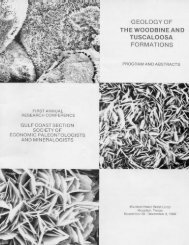Petroleum Systems of Deep-Water Basins - Gulf Coast Section SEPM
Petroleum Systems of Deep-Water Basins - Gulf Coast Section SEPM
Petroleum Systems of Deep-Water Basins - Gulf Coast Section SEPM
You also want an ePaper? Increase the reach of your titles
YUMPU automatically turns print PDFs into web optimized ePapers that Google loves.
Hydrocarbon <strong>Systems</strong>—Adding Structural Evolution<br />
to the Equation<br />
Alan Gibbs<br />
Paul Griffiths<br />
Serena Jones<br />
Midland Valley Exploration<br />
14 Park Circus<br />
Glasgow<br />
KA3 6AR Scotland UK<br />
alan@mve.com<br />
Abstract<br />
This paper outlines new techniques developed to enable the hydrocarbon system to be fully integrated with the<br />
structure model and its evolution through time. The approach was developed to tackle hydrocarbon system problems<br />
in complex structural areas where inversion, salt tectonics, or thrust faulting has lead to complex changes in the 3D<br />
fairways through time. The technique provides the ability to identify and assess risk in hydrocarbon system models<br />
and to generate multiple scenarios. This provides improved input into 2D and 3D basin modeling and allows the key<br />
system components to be integrated through depositional stages, faulting and folding and migration.<br />
Using 3D interpretations, a validated back-stripped model provides the basis for modeling sediment pathway and<br />
fluid migration fairways at each time step. As the model is run forwards in time, sediment accommodation space and<br />
sediment transfer analysis is carried out. This analysis is then integrated with the depositional model. Sub basin spillways,<br />
stacking and migration <strong>of</strong> depocenters can be identified. Using input from basin modeling to identify kitchen<br />
areas and timing the migration pathways, fluid focusing and drainage cell analysis can be carried out. Models for fault<br />
seal / non-seal, fairways through channels, and compartmentalization can be investigated.<br />
This analysis can then be used to develop and condition appropriate detailed 2 or 3D basin models or applied<br />
directly to technical and commercial decision making in exploration. This approach has been successfully applied to<br />
projects in the North Sea, deep water <strong>Gulf</strong> <strong>of</strong> Mexico, Central and South America, North Africa, and the Atlantic margin.<br />
In these areas it has demonstrated clear benefit in significantly reducing work cycle times and in providing<br />
technical results that are significantly different from the conventional approaches which have not included the effect<br />
<strong>of</strong> lateral displacements through time during structural evolution.<br />
24

















